一 : 撑起成都美食的居然是叔叔嬢嬢
今天给大家盘点一篇美食帖
那些年
撑起成都美食界半壁江山的
叔叔孃孃些
来看看
我保证这里面你认识好多!

二孃鸡爪爪

作为四川比较特色的鬼饮食,鸡爪爪占有很重要的地位,本地人吃起来都带感情,这里的鸡爪是四川九十年代路边小吃麻辣烫的做法,很多种香料搭配成,不会很多油,鸡爪的糯会让汤汁肥美不腻,入口骨头就脱落了,标准的好吃。[www.61k.com)
地址:双流县向阳街29号
电话: 13438977725
人均:43元
张孃烤肉

肉好吃,都是码了料的,点鹌鹑里面就带洋葱的,五花肉真是油爆爆的啊,推荐要干碟,因为锅和肉都很油了,吃不完就打包回家了,在家用锡纸包着烤了一下,也是蛮好吃的,环境没啥说的,就是苍蝇馆子,他们家还有袖套围裙,不算太干净,但服务态度端正。
地址:青羊区育婴堂街20号(近十一中)
人均:61元
李孃兔头
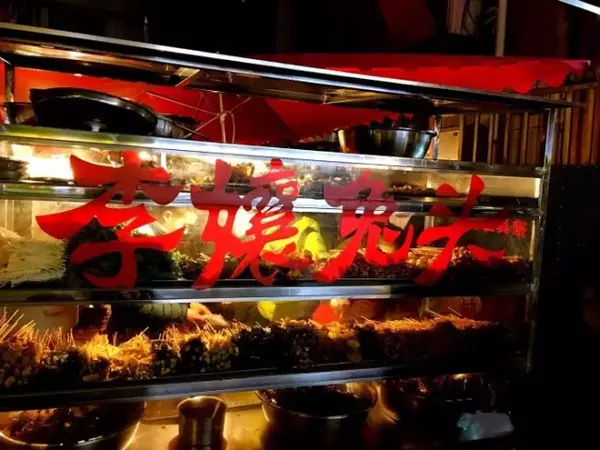
下午5点开始摆摊,直到第二天凌晨4点,坐满了人,是重口味娃儿的天堂,吃得冒汗,喝得打颤,吹得起劲,辣得板命。麻辣兔头和五香兔头让爱啃一族欲罢不能,鸭头,脖子,鸡爪,鸭掌也是味道重,油水浓,卤得耙,下酒快,最重要的是越吃越想吃!
地址:青羊区西安中路45号(近西安南路北站牌)
人均:32元
巫孃土豆
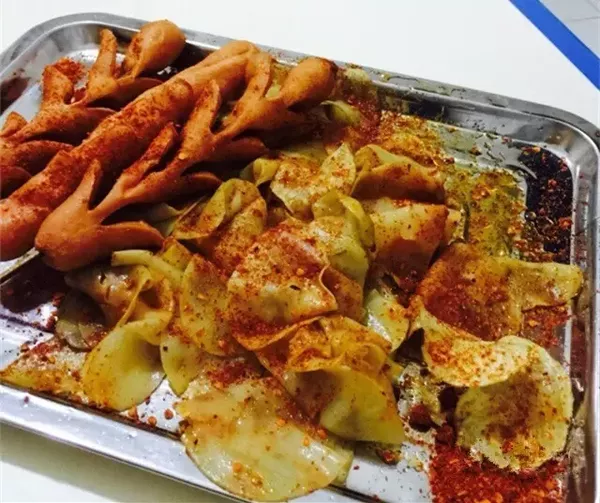
这里食客众多,人满为患!厨房很小,巫嬢边摆龙门阵边给你弄土豆!有冒土豆和炸土豆还有火腿肠这三种!土豆很薄,可以加醋加粉儿!炸土豆片片上面撒上海椒面抹上油好好吃啊!火腿肠炸到恰到好处,皮脆肉干爽!超级有特色一家小吃店啊!
地址:新都公园路33号(近饮马河)
电话:028-83931978
人均:10元
李孃孃沾水米线

位置比较好找,负一楼一下去就能看到。饭点时很多人排队。味道还是没有让我失望的,在成都每天都吃得油又辣,胃都快受不了了,这个清淡的米线很适合。汤底很鲜美,宣传上说奇怪大骨熬制的。还配送有爽口的小菜,反而是这样一碗简单的米线更好吃!
地址:武侯区凯丹广场B1楼大象厨房内
电话:13678468620
人均:15元
小孃钵钵鸡
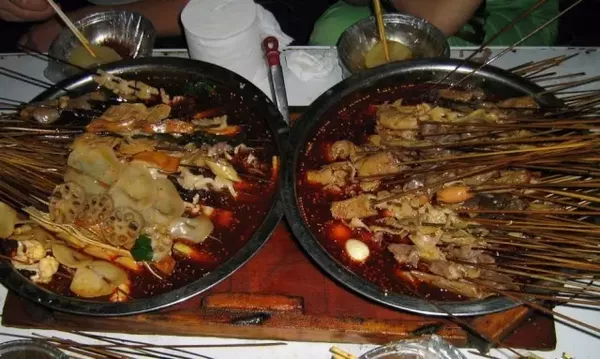
双林路小学旁一个居民小区一楼。不是好吃嘴儿些带起去可能真不知道这么一个地方。钵钵鸡冒热了来吃。咸淡适中,也不辣,配个干碟子也刚好合适。他家兔儿脑壳是一绝,朋友们吃的开心。第二天也没有拉肚子,非常不错。3个人吃下来很撑才70多,价格实在。
地址:成华区双桥路(近双林小学)
电话:13666297056
人均:29元
————说完孃孃我们就来说叔叔哇————
嘘嘘大叔
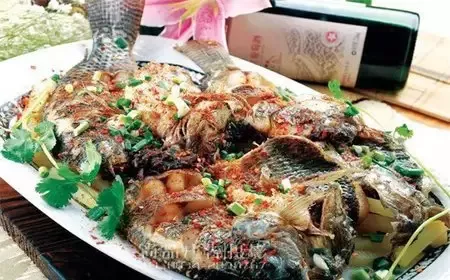
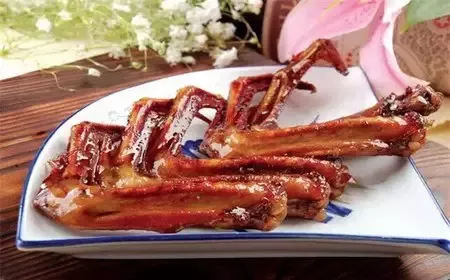
好多吃过的朋友,都说味道好,菜品有特色,就是位置偏,不好找啊。烧烤五花肉特别好吃,牛肉,肥肠,包浆豆腐,脑花就更莫摆了。正宗西昌口味噢!泡椒味的罗非鱼力荐!元根酸菜味的汤非常鲜美…莫得鱼腥、土腥等各种奇怪腥味啊!调味也是一吃就晓得是资格西昌儿女弄出来的啊!巴适得板啊!
地址:锦江区经天西路7号
人均:60闷
Lee叔叔的龙虾馆
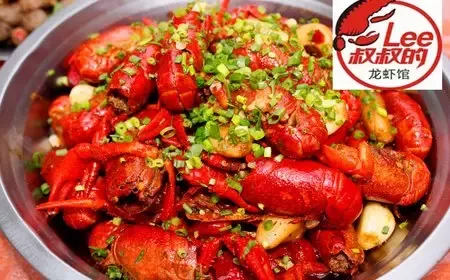

环境还不错,符合半苍蝇馆味道又好的标准。服务挺热情的,虾挺干净的,每次去都能看到服务员在仔细洗虾,偶尔会遇到个头很大的虾,看运气哈。名气在那,怎么也差不了的。成都来说很不错了。就是堂子有点小,人多,切晚咯就要等多久!上菜很快!鱼香味是他们的招牌,虾大,肉多,新鲜,分量足!
地址:金仙桥路和马家花园路十字路口(农业银行旁小河处)
电话:028-87663695
人均:98闷
莽叔的小秘蜜


他们家的黑巧绝对是不容错过的好东西,好多人就是冲着这个去的然后回头客之多。黑巧口感细腻味道醇厚,会让第一次的人感到惊喜!其次即使推荐图二另一个主打——坚果五侠套餐!一口气吃五根!真的是一点都不腻!
地址:成都市锦江区二环路东四段(牛市口地铁站)
电话:15680098809
人均:60闷
喵叔的实验室


这家主打的是曲奇,都是现烤的很好吃,过最好吃的曲奇。推荐西梅和巧克力夹心的,巧克力的微波炉叮15秒简直了,咖啡味道很淡很淡,软曲奇喜欢因为完全不会甜腻,特別是雪梨入口很有果味。悄悄告诉你网上团购老板还有多送一块曲奇哦。
地址:水碾河南三街37号U37创意仓库(娇子音乐厅)
电话:028-84455571
人均:25闷
萌叔砂锅麻辣烫


很久之前就知道这里有一家国际青旅,这家麻辣烫店居然就是青旅开的。一进去整个店面都是东方紅的紅色记忆!装潢风格也是老成都那种味道,很怀旧,很多书的小人书连环画那些。属于是院坝头搭的蓬蓬,空间很高,砂锅是地道本土麻辣烫的味道。料端上來很香,串串也很干净,在这里吃串串真的氛围够了啊!
地址:致民路48号
电话:028-85454994
人均:30闷
凉山大叔火盆烧烤

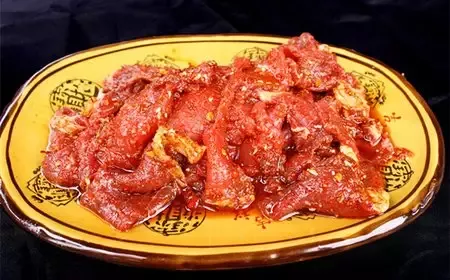
喜欢吃烧烤的好吃嘴有口福了!招牌菜凉山生态烤鸡,地地道道的凉山美食,每只鸡都是从大凉山运过来的散养野鸡,带皮带骨一起烤制,香飘四溢。烤小肠,蘸上干辣椒面,皮酥肉嫩。烤牛肉,将上等牛肉切成薄片,在火盆上翻烤数十秒即可食用,包上生菜,口感较佳。秘制烤全茄,里面包裹着特色风味馅料,若倒入啤酒,风味更特别。
地址:同善横街同乐苑内(好家乡旁)
电话:18208197615
人均:65闷
奎叔兔头


精选新鲜上等兔头,肉多细嫩,味道堪称一绝,真空包装,精美外袋,每袋配有贴心一次性手套、纸巾、牙签等,方便食用,是休闲必备的好零食!烧烤味应该是这家的特色,锡纸包着的,兔头表面还裹了一些金针菇,兔头很软,轻轻一掰就开了,味道不麻不辣,刚合适!
地址:水碾河路37号(娇子音乐厅)
电话:15680001517
人均:22闷
甜叔叔


春熙闹中取静的地方,适合小坐看看书,发发呆,咖啡好喝,环境安静。装修很有味道,有很多老东西,小时候的风扇,黑白电视 和独特位子都是隔起来的,私密性很好。带上一本书,点一份薯条套餐,绝对是不错的选择,非常惬意!
地址:华兴街15号(华兴街消防总队对面)
电话:028-66880883
人均:35闷
表叔茶餐厅
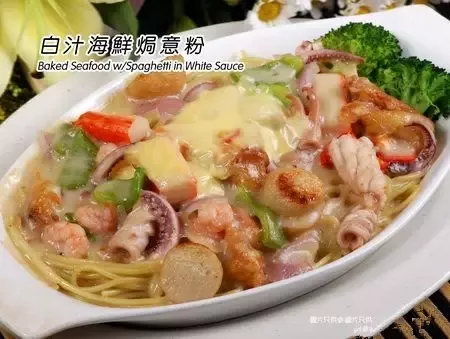
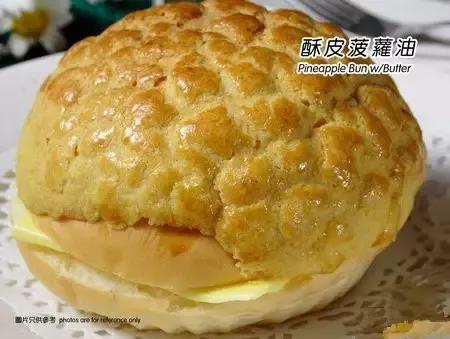
他们家还是很多菜是正宗的,必点的是印尼炒饭和茶走!装修风格很有HK路边小店的感觉,味道也不错,咖喱牛腩饭,份量足,牛肉也很烂,用来拌饭味道好,食物很正宗,就是人太多!上菜慢!
地址:大业路6号盐市口财富中心店
电话:028-69681337
人均:53闷
河马叔叔披萨


这家披萨纯手工的,味道不错,方圆五公里内配送,很多附近的客人都喜欢点单,披萨比较Q,芝士放得多,味道很棒,比必胜客的感觉都要好!外卖的服务很好,有时候很晚了还送会送货上门!
地址:一环路南二段磨子桥旅游村
电话:18628156397
人均:34闷
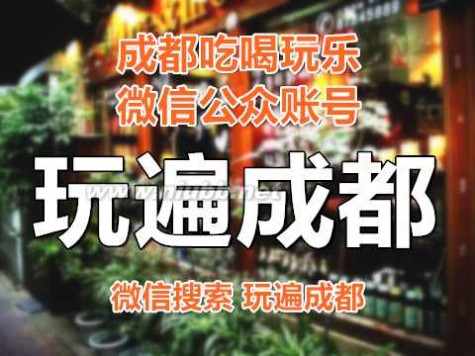
青钩子娃娃,带你玩遍成都
欢迎呆在成都的你,与我交朋友
微信:CD512028
二 : 关于广州的这些美食传说 以后可以讲给儿子孙子听!

说起广州,你的第一印象想到什么?可能是闻名在外的小蛮腰、白云山,可能是好听又温柔的广东话和粤语歌曲,也可能是广州的美食!
广州美食在大众眼里一向是有口皆碑的,各式的广式茶点、甜品,还有各种丰富的粤系菜式,都让很多人对广州这座城市留下了深刻的印象。(www.61k.com)
广州的美味小吃,相信你吃过不少,可是你知道吗?这些平日极为常见的美食,也藏着让人感叹不已的故事。
今天U仔就和大家一起来了解下,这些美食背后都有什么样的美丽传说。

干炒牛河
干炒牛河应该是广州最普遍最常见的了。早餐吃炒牛河,午餐吃炒牛河,晚餐和宵夜还能吃炒牛河。广州人对河粉的热爱程度绝对不亚于韩国人对泡菜的热爱程度了!
话说,“河粉”一词,源出广东沙河镇的“沙河粉”简称,而沙河镇如今就在最多型人潮人聚居的珠江新城猎德地铁站附近。
清末民初时,当地有家茶寮叫义和居,老板姓范(也有讹称姓樊),无意发现将米浆蒸熟切成条状,再洒点酱油葱花,居然非常可口,这就是沙河粉的雏形。据说义和居用的是越南大米加白云山泉水磨成米浆,特别细腻幼滑,在战前名声大起。不过抗战广州沦陷前,日军曾对广州空袭了十四个月,义和居不幸地正是毁于当时战火,如今已无迹可寻。
话说在广州沦陷之前,炒河粉只有湿炒(例如现在的豉椒牛河),炒熟的豆豉辣椒菜蔬牛肉勾芡码放在沙河粉上。而广州沦陷后,汪伪政权招募了大量流氓地痞组成“侦缉大队”,监管普通市民。
传说是这样的:
有一天晚上,侦辑大队的一个队长与手下,来到一家由许姓母子三人经营的大牌档吃宵夜,点了炒牛河。由于档口的生粉刚用完,勾不了芡汁,许家母子原想借此推辞,恃势凌人的侦辑大队队长借势发起难来。老板娘灵机一动,让儿子以“料头”先爆香牛肉,再加酱油炒河粉,最后炒进银芽韮黄。队长吃过后竟然连连赞好,从此干炒牛河便在广东菜粉面类发扬光大。
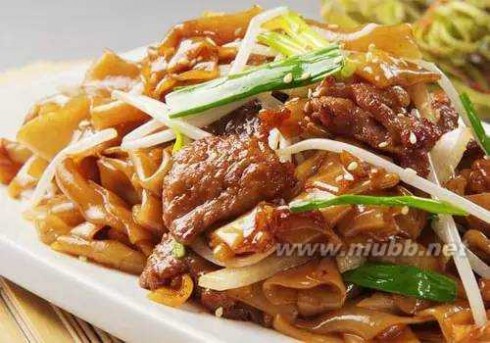
艇仔粥
艇仔粥是广州著名的小吃,广东粥品之一。以鱼片、炸花生等多种配料加在粥中而成。原为一些水上人家用小船在荔枝湾河,珠江边上贩卖,花生,小虾香脆,鱼片,蛋丝软滑,鲜甜香美,适合众人口味。
而关于“艇仔粥”还有一个典故:
相传有一个船上人家的女孩叫金水,心地非常善良。 一日她把父亲捕到的一条鲤鱼放回到江里。过了几年金水的父亲患了重病,她非常伤心,来到江边祈求仙人保佑。这时一位仙女从水中出来说:“我是几年前被你救的鲤鱼。你只要煮一些鱼虾粥再加些油脆之物卖给人家,便可换钱带你爹去看大夫,10日之内即可痊愈。”金水依法照做治好的父亲的病,从此这粥就被取名为“艇仔粥”。
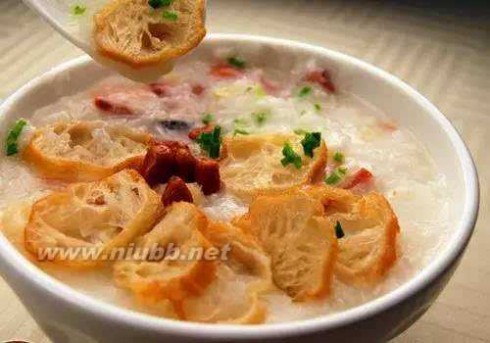
公鸡榄
也许你逛上下九的时候经常会看到这样一些人,身上背着一个公鸡造型的“坐骑”,吹着唢呐,向游客兜售着腌制好的橄榄。没错,这就是公鸡榄了。
“公鸡榄”,本名是甘草榄,也叫“卜卜榄”,卖榄人挂着一支唢呐走天涯,边走边吹。一包一包腌好的橄榄有辣有不辣。公鸡榄由鲜白榄秘制,是用甘草等药材及盐腌制造而成的,放了很久也不变坏,甘草味浓但好吃。是当年流行于省、港澳地区的一种销售干果零食的一种方法,历史很长。过去公鸡榄沿街叫卖,由于买榄人有个公鸡骑故名为公鸡榄。
传说中因为家住三四楼的人太懒,最早时用绳子系上篮子取榄给钱,但这比较慢,买榄人后直接把榄包好投到楼上阳台,客厅中。后来,卖榄人练就一身功夫总可以把公鸡榄准确无误的投到各家各户的阳台和窗户上去,楼上人把钱再抛下来就可以了。

肠粉
肠粉是广东地区的特色小吃,大街小巷,无人不知,无人不晓。早在清代末期,广州街头上就已经听到卖肠粉的叫卖声。那时候,肠粉分咸、甜两种,咸肠粉的馅料主要有猪肉、牛肉、虾仁、猪肝等,而甜肠粉的馅料则主要是糖浸的蔬果,再拌上炒香芝麻。
而肠粉主要流派有两种,一种是布拉肠粉,另一种是抽屉式肠粉。布拉肠粉是以品尝馅料为主(肠粉浆大部分是使用粘米粉再添加澄面、粟粉和生粉),而抽屉式肠粉(肠粉浆是使用纯米浆做成)主要品尝肠粉粉质和酱汁调料!
传说是乾隆皇帝游江南那会儿,受了吃客大臣纪晓岚的蛊惑,专门拐去粤西吃肠粉。当吃到这种“够爽、够嫩、够滑”的东西时,乾隆赞不绝口,并乘兴说:“这米粉有点像猪肠子”。肠粉在广东是最为普遍的早餐,看起来粉皮白如雪花、薄如蝉翼、晶莹剔透,吃起来鲜香满口、细腻爽滑、还有一点点韧劲,让人一吃难忘。

姜撞奶
说了那么多美味小吃,该说说广州的甜品了。姜撞奶在广州也是出了名的甜品小吃,是以姜汁和牛奶为主要原料加工制作而成的一种甜品。味道香醇爽滑,甜中微辣、风味独特且有暖胃表热作用。
关于姜撞奶,还有这么一个传说:从前,在广州番禺沙湾镇,一个年迈的老婆婆犯了咳嗽病,后知道姜汁可治咳嗽,但姜汁太辣,老婆婆无法喝下去,媳妇不小心把奶倒入装姜汁的碗里,奇怪的是过了一阵子牛奶凝结了,婆婆喝了后顿觉满口清香。第2天病就好了。因此姜撞奶就在沙湾镇流传开了,沙湾人把“凝结”叫“埋”,于是“姜撞奶”在沙湾也叫“姜埋奶”。
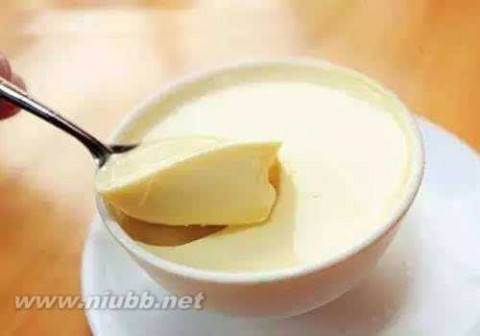
萝卜牛杂
有这么一种说法,认识广州就得从萝卜牛杂开始,也有人说,没吃过萝卜牛杂的人算不上真正的广州人。
如果你曾到过珠三角,却未曾吃过一碗萝卜牛杂,你的美食之旅一定是带着点遗憾的。现在广州乃至整个珠三角各大步行街,都会有卖萝卜牛杂的小店。如果你看到许多广东人,特别是年轻一族,一手拿着一个小小的泡沫碗,一手拿着竹签,站在最繁华的街头,无视来来往往的人群,毫不顾仪态地站在路边吃得津津有味的话。不用猜,他们一定吃的是萝卜牛杂。
而关于这个不得不说的美味小吃,民间流传着这样一个传说:
传说在清朝的光绪年间,清末民初之际,回民吃肉是极其不易的,只要有水牛宰杀,回民们往往奔走相告。一位回民厨师阿德发现人们每次宰牛后,肺、肠、肚等常常丢弃,觉得浪费,于是带回家中,别出心裁要创一佳肴。他买回价廉又容易入味的萝卜,配以五香味料慢火煨煮,烂熟后剪碎蘸辣酱吃,赋以美名——“牛杂萝卜”。这“牛杂萝卜”一出,别说难得油水下肚的回民难挡诱惑,就连广州居民也纷纷仿效,“牛杂萝卜”迅速流传至广东各地,许多客人都是站着吃,由此站着吃牛杂成为了吃牛杂传统的固定模式。
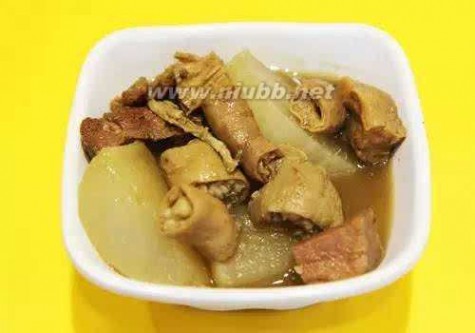
及第粥
如果说除了艇仔粥皮蛋瘦肉粥之外,还有什么粥是广州人的最爱,那必须是及第粥了。初听这个名字也许觉得有点怪,客官别急,且听我慢慢道来。
正宗的及第粥,用猪瘦肉丸、猪肝片、猪粉肠加入粥中煮熟而成。色白鲜明,糜水交融,味鲜香厚。讲究粥底绵滑,白米粥熬到米粒全化。客人点时,舀入小锅烧滚,加猪心、猪肝和猪粉肠,滚熟后盛碗,撒花生米,切碎油条,伴小碟鸡蛋散上桌。
“及第”一名与明代广东才子伦文叙有关,相传伦氏幼时家中甚贫,以卖菜为生。隔壁粥贩怜其幼,惜其才,每天中午以买菜为名,让伦文叙送一担菜至粥贩家,送完菜后,粥贩便以猪肉丸、猪粉肠、猪肝生滚的白粥招待之,权当午餐。后来伦氏高中,心念粥贩赠粥之恩,重回故地食了一碗当年老板给他熬的那种粥。由于此粥无名,伦氏为其题名“及第”,并书一匾。“及第粥”之名,便由之传遍广州。而猪内脏又称“杂底”,美化为“及第”,成为卖点。十分鲜味可口。

糯米鸡
初来广州的朋友可能会混淆,以为糯米鸡就是粽子。虽说两者有相似之处,但仔细比较起来,还是大有不同。
糯米鸡是在糯米里面放入鸡肉、叉烧肉、咸蛋黄、冬菇等馅料,然后以荷叶包实放到蒸具蒸熟。糯米鸡入口充满着荷叶的清香,咀嚼时黏牙并带有着鸡肉的肉香。
相传糯米鸡起源是解放前广州的夜市,最初是以碗盖着蒸熟而成,后来为小贩为方便肩挑出售,改为以荷叶包裹。古代糯米鸡以糯米、瑶柱、虾干粒,或去骨的鸡翅等作馅料精制而成。传统的糯米鸡的份量较大,足有三四两米,吃一个糯米鸡已差不多是半顿饭量。因此,1980年代起的广东酒楼推出材料相同,而体积小一半的“珍珠鸡”。
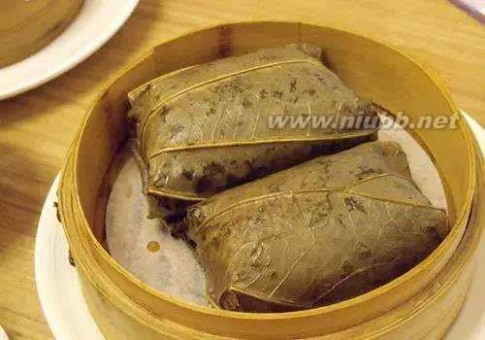
粉粿
粉粿在广东已经是家喻户晓的家常点心了,也是每次去酒楼饮茶必点的一道美食。
古时候,粉粿是以米饭舂成的米粉撞热开水搓成粉粿皮,而现代已各改用生粉掺澄面代替,馅料亦较以前考究,有肥瘦肉丁、叉烧粒、虾仁、冬菇、竹笋、芫荽等。
传说从前佛山顺德一带养蚕缫丝,工业盛行,许多可以自食其力、不愿出嫁受夫家约束的女子相约为“自梳女”,彼此终生不婚互相扶持,成为当地风俗。到晚清民初时工业革命的浪潮终卷到中国时,土法生产的地方工业相继破产,原本在桑园和缫丝厂打工的自梳女失业,为了生计只有转到大户人家去当女佣,称为“妈姐”。粉粿就是出自这群巧手的仆妇。
话说当时有位叫娥姐的妈姐,原在西关一家富户当女佣,平素看到有剩下的冷饭,不忍就此丢掉,便把冷饭和用水浸泡过的粘米一起来舂为粉粿皮,里头再包些菜脯粒虾米芫荽瘦肉虾仁之类,老爷太太品尝后赞赏不已,渐渐成为这户人家款客必备之物。
他们有个姓黄的通家之好,叫黄佩刚,既然是通家之好,当然也吃过娥姐的巧手粉粿。当时广州时兴一种食肆叫“茶室”——较之传统茶楼,没有那份喧闹嘈吵,点心倒像今天,是有张单子让客人挑选,而非传统的一迭迭蒸笼推到店面,气氛斯文细致得多,装修也是雅致的酸枝家具配山水字画,与 “二厘馆”式以普罗大众为主的茶居风格迥异——人称“黄大少”的黄佩刚当时正打算在西关开一家这样的茶室,于是重金礼聘娥姐掌厨,“茶香室”的“娥姐粉粿”因为“皮薄馅靓”,很快名气传遍广州。娥姐粉粿的故事甚有传奇色彩,黄大少和娥姐相继过世后的五六十年代还被拍成黑白粤语片流传。
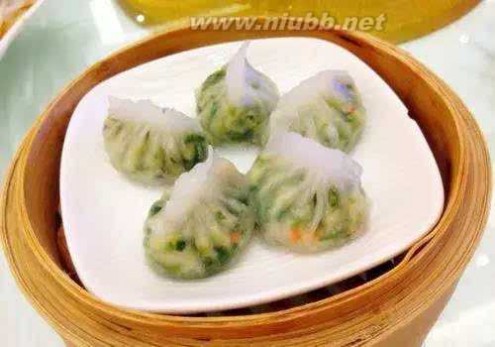
虾饺
虾饺和粉粿可称为广州茶楼里的一对双胞胎姐妹了,点了粉粿不点虾饺,怎么好意思说你在广州吃过早茶?
虾饺起源于广州郊外靠近河涌集市的茶居。传统的虾饺是半月形、蜘蛛肚共有十二褶的,馅料有虾,有肉,有笋,味道鲜美爽滑,美味可口,深受海内外食客赞誉。
虾饺始创于20世纪初广州市郊伍村五凤乡的一间家庭式小茶楼。相传当时的伍村很繁荣,地方幽美,一河两岸,河面经常有渔艇叫卖鱼虾。这家酒楼老板为了招徕顾客,便别出心裁,收购当地出产的鲜虾,加上猪肉、笋等作馅料制成虾饺。当时虾饺皮厚不光亮,但因新奇,味道又鲜美,赢得了食客的喜欢,不久便名饧广州,各大酒楼争相制售,并经点心师的改革,将原料用面粉改成“澄粉”,效果特佳,更加吸引客人。
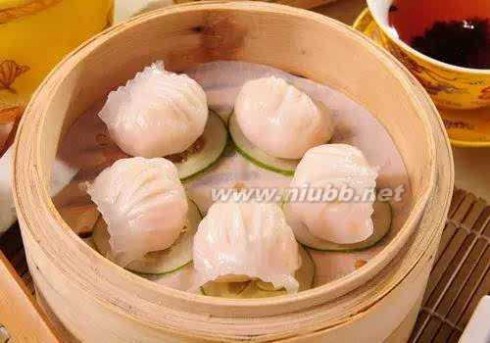
来源:羊城地铁报
三 : 2000/13/EC 关于食品标签、说明和广告宣传的成员国相似法案(On the approximation of the laws of the Member States relating to the labelling, presentation and advertising of foodstuffs)
Amended by:
| Official Journal | ||||
| No | page | date | ||
| Commission Directive2001/101/ECof 26 November 2001 | L310 | 19 | 28.11.2001 | |
| Directive2003/89/ECof the European Parliament and of the Council of 10 November 2003 | L308 | 15 | 25.11.2003 | |
| Council Directive2006/107/ECof 20 November 2006 | L363 | 411 | 20.12.2006 | |
| Commission Directive 2006/142/EC of 22 December 2006 | L368 | 110 | 23.12.2006 | |
| Commission Directive 2007/68/EC of 27 November 2007 | L310 | 11 | 28.11.2007 | |
| Regulation (EC) No 1332/2008 of the European Parliament and of the Council of 16 December 2008 | L354 | 7 | 31.12.2008 | |
| Regulation (EC) No 1334/2008 of the European Parliament and of the Council of 16 December 2008 | L354 | 34 | 31.12.2008 | |
| Regulation (EC) No 596/2009 of the European Parliament and of the Council of 18 June 2009 | L188 | 14 | 18.7.2009 | |
| Act concerning the conditions of accession of the Czech Republic, the Republic of Estonia, the Republic of Cyprus, the Republic of Latvia, the Republic of Lithuania, the Republic of Hungary, the Republic of Malta, the Republic of Poland, the Republic of Slovenia and the Slovak Republic and the adjustments to the Treaties on which the European Union is founded | L236 | 33 | 23.9.2003 | |
Corrected by:
Corrigendum, OJ L 124, 25.5.2000, p. 66 (2000/13/EC)
THE EUROPEAN PARLIAMENT AND THE COUNCIL OF THE EUROPEAN UNION,
Having regard to the Treaty establishing the European Community, and in particular Article 95 thereof,
Having regard to the proposal of the Commission,
Having regard to the opinion of the Economic and Social Committee ( 1 ),
Acting in accordance with the procedure laid down in Article 251 of the Treaty ( 2 ),
Whereas:
(1) Council Directive 79/112/EEC of 18 December 1978 on the approximation of the laws of the Member States relating to the labelling, presentation and advertising of foodstuffs ( 3 ) has been frequently and substantially amended ( 4 )。 Therefore, for reasons of clarity and rationality, the said Directive should be consolidated in a single text.
(2) Differences between the laws, regulations and administrative provisions of the Member States on the labelling of foodstuffs may impede the free circulation of these products and can lead to unequal conditions of competition.
(3) Therefore, approximation of these laws would contribute to the smooth functioning of the internal market.
(4) The purpose of this Directive should be to enact Community rules of a general nature applicable horizontally to all foodstuffs put on the market.
(5) Rules of a specific nature which apply vertically only to particular foodstuffs should be laid down in provisions dealing with those products.
(6) The prime consideration for any rules on the labelling of foodstuffs should be the need to inform and protect the consumer.
(7) That need means that Member States may, in compliance with the rules of the Treaty, impose language requirements.
(8) Detailed labelling, in particular giving the exact nature and characteristics of the product which enables the consumer to make his choice in full knowledge of the facts, is the most appropriate since it creates fewest obstacles to free trade.
(9) Therefore, a list should be drawn up of all information which should in principle be included in the labelling of all foodstuffs.
(10) However, the horizontal nature of this Directive does not allow, at the initial stage, the inclusion in the compulsory indications of all the indications which must be added to the list applying in principle to the whole range of foodstuffs. During a later stage, Community provisions should be adopted, aimed at supplementing the existing rules.
(11) Furthermore, in the absence of Community rules of a specific nature Member States should retain the right to lay down certain national provisions which may be added to the general provisions of this Directive, nevertheless these provisions should be subject to a Community procedure.
(12) The said Community procedure must be that of a Community decision when a Member State wishes to enact new legislation.
(13) Provision should also be made for the Community legislator to derogate, in exceptional cases, from certain obligations that have been fixed generally.
(14) The rules on labelling should also prohibit the use of information that would mislead the purchaser or attribute medicinal properties to foodstuffs. To be effective, this prohibition should also apply to the presentation and advertising of foodstuffs.

(15) With a view to facilitating trade between Member States, it may be provided that, at stages prior to sale to the ultimate consumer, only information on the essential elements should appear on the outer packaging and certain mandatory particulars that must appear on a prepackaged foodstuff need appear only on commercial documents referring thereto.
(16) Member States should retain the right, depending on local practical conditions and circumstances, to lay down rules in respect of the labelling of foodstuffs sold in bulk; in such cases, information should nevertheless be provided for the consumer.
(17) With the aim of simplifying and accelerating the procedure, the Commission should be entrusted with the task of adopting implementing measures of a technical nature.
(18) The measures necessary for the implementing of this Directive should be adopted in accordance with Council Decision 1999/468/EC of 28 June 1999 laying down the procedures for the exercise of implementing powers conferred on the Commission ( 1 )。
(www.61k.com)(19) This Directive should be without prejudice to the obligations of the Member States concerning the time limits for transposition of the Directives set out in Annex IV, Part B,
HAVE ADOPTED THIS DIRECTIVE:
Article 1
1. This Directive concerns the labelling of foodstuffs to be delivered as such to the ultimate consumer and certain aspects relating to the presentation and advertising thereof.
2. This Directive shall apply also to foodstuffs intended for supply to restaurants, hospitals, canteens and other similar mass caterers (hereinafter referred to as ‘mass caterers’)。
3. For the purpose of this Directive,
(a) 'labelling' shall mean any words, particulars, trade marks, brand name, pictorial matter or symbol relating to a foodstuff and placed on any packaging, document, notice, label, ring or collar accompanying or referring to such foodstuff;
(b) 'pre-packaged foodstuff' shall mean any single item for presentation as such to the ultimate consumer and to mass caterers, consisting of a foodstuff and the packaging into which it was put before being offered for sale, whether such packaging encloses the foodstuff completely or only partially, but in any case in such a way that the contents cannot be altered without opening or changing the packaging.
Article 2
1. The labelling and methods used must not:
(a) be such as could mislead the purchaser to a material degree, particularly:
(i) as to the characteristics of the foodstuff and, in particular, as to its nature, identity, properties, composition, quantity, durability, origin or provenance, method of manufacture or production;
(ii) by attributing to the foodstuff effects or properties which it does not possess;
(iii) by suggesting that the foodstuff possesses special characteristics when in fact all similar foodstuffs possess such characteristics;
(b) subject to Community provisions applicable to natural mineral waters and foodstuffs for particular nutritional uses, attribute to any foodstuff the property of preventing, treating or curing a human disease, or refer to such properties.
2. The Council, in accordance with the procedure laid down in Article 95 of the Treaty, shall draw up a non-exhaustive list of the claims within the meaning of paragraph 1, the use of which must at all events be prohibited or restricted.
3. The prohibitions or restrictions referred to in paragraphs 1 and 2 shall also apply to:
(a) the presentation of foodstuffs, in particular their shape, appearance or packaging, the packaging materials used, the way in which they are arranged and the setting in which they are displayed;
(b) advertising.
Article 3
1. In accordance with Articles 4 to 17 and subject to the exceptions contained therein, indication of the following particulars alone shall be compulsory on the labelling of foodstuffs:
(1) the name under which the product is sold;
(2) the list of ingredients;
(3) the quantity of certain ingredients or categories of ingredients as provided for in Article 7;
(4) in the case of prepackaged foodstuffs, the net quantity;
(5) the date of minimum durability or, in the case of foodstuffs which, from the microbiological point of view, are highly perishable, the 'use by' date;
(6) any special storage conditions or conditions of use;
(7) the name or business name and address of the manufacturer or packager, or of a seller established within the Community.
However, the Member States shall be authorised, in respect of butter produced in their territory, to require only an indication of the manufacturer, packager or seller.
Without prejudice to the notification provided for in Article 24, Member States shall inform the Commission and the other Member States of any measure taken pursuant to the second paragraph;
(8) particulars of the place of origin or provenance where failure to give such particulars might mislead the consumer to a material degree as to the true origin or provenance of the foodstuff;
(9) instructions for use when it would be impossible to make appropriate use of the foodstuff in the absence of such instructions;
(10) with respect to beverages containing more than 1,2 % by volume of alcohol, the actual alcoholic strength by volume.
2. Notwithstanding the previous paragraph, Member States may retain national provisions which require indication of the factory or packaging centre, in respect of home production.
3. The provisions of this Article shall be without prejudice to more precise or more extensive provisions regarding weights and measures.
Article 4
1. Community provisions applicable to specified foodstuffs and not to foodstuffs in general may provide for derogations, in exceptional cases, from the requirements laid down in Article 3(1), points 2 and 5, provided that this does not result in the purchaser being inadequately informed.
2. Community provisions applicable to specified foodstuffs and not to foodstuffs in general may provide that other particulars in addition to those listed in Article 3 must appear on the labelling.
Where there are no Community provisions, Member States may make provision for such particulars in accordance with the procedure laid down in Article 19.
3. The Community provisions referred to in paragraphs 1 and 2 shall be adopted by the Commission. Those measures, designed to amend non-essential elements of this Directive by supplementing it, shall be adopted in accordance with the regulatory procedure with scrutiny referred to in Article 20(3)。
Article 5
1. The name under which a foodstuff is sold shall be the name provided for in the Community provisions applicable to it.
(a) In the absence of Community provisions, the name under which a product is sold shall be the name provided for in the laws, regulations and administrative provisions applicable in the Member State in which the product is sold to the final consumer or to mass caterers.
Failing this, the name under which a product is sold shall be the name customary in the Member State in which it is sold to the final consumer or to mass caterers, or a description of the foodstuff, and if necessary of its use, which is clear enough to let the purchaser know its true nature and distinguish it from other products with which it might be confused.
(b) The use in the Member State of marketing of the sales name under which the product is legally manufactured and marketed in the Member State of production shall also be allowed.
However, where the application of the other provisions of this Directive, in particular those set out in Article 3, would not enable consumers in the Member State of marketing to know the true nature of the foodstuff and to distinguish it from foodstuffs with which they could confuse it, the sales name shall be accompanied by other descriptive information which shall appear in proximity to the sales name.
(c) In exceptional cases, the sales name of the Member State of production shall not be used in the Member State of marketing when the foodstuff which it designates is so different, as regards its composition or manufacture, from the foodstuff known under that name that the provisions of point (b) are not sufficient to ensure, in the Member State of marketing, correct information for consumers.
2. No trade mark, brand name or fancy name may be substituted for the name under which the product is sold.
3. The name under which the product is sold shall include or be accompanied by particulars as to the physical condition of the foodstuff or the specific treatment which it has undergone (e.g. powdered, freeze-dried, deep-frozen, concentrated, smoked) in all cases where omission of such information could create confusion in the mind of the purchaser.
Any foodstuff which has been treated with ionising radiation must bear one of the following indications:
. Article 6
1. Ingredients shall be listed in accordance with this Article and Annexes I, II, III and IIIa.
2. Ingredients need not be listed in the case of:
(a)-fresh fruit and vegetables, including potatoes, which have not been peeled, cut or similarly treated,
-carbonated water, the description of which indicates that it has been carbonated,
-fermentation vinegars derived exclusively from a single basic product, provided that no other ingredient has been added;
(b)-cheese,
-butter,
-fermented milk and cream,
provided that no ingredient has been added other than lactic products, enzymes and micro-organism cultures essential to manufacture, or the salt needed for the manufacture of cheese other than fresh cheese and processed cheese;
(c) products comprising a single ingredient, where:
-the trade name is identical with the ingredient name, or
-the trade name enables the nature of the ingredient to be clearly identified.
3. In the case of beverages containing more than 1,2 % by volume of alcohol, the Council, acting on a proposal from the Commission, shall, before 22 December 1982, determine the rules for labelling ingredients.
3a. Without prejudice to the rules for labelling to be established pursuant to paragraph 3, any ingredient, as defined in paragraph 4(a) and listed in Annex IIIa, shall be indicated on the labelling where it is present in beverages referred to in paragraph 3. This indication shall comprise the word 'contains' followed by the name of the ingredient(s) concerned. However, an indication is not necessary when the ingredient is already included under its specific name in the list of ingredients or in the name under which the beverage is sold.
Where necessary, detailed rules for the presentation of the indication referred to in the first subparagraph may be adopted in accordance with the following procedures:
(a) as regards the products referred to in Article 1(2) of Council Regulation (EC) No 1493/99 of 17 May 1999 on the common organisation of the market in wine ( 1 ), under the procedure laid down in Article 75 of that Regulation;
(b) as regards the products referred to in Article 2(1) of Council Regulation (EEC) No 1601/91 of 10 June 1991 laying down general rules on the definition, description and presentation of aromatised wines, aromatised wine-based drinks and aromatised wine-product cocktails ( 1 ), under the procedure laid down in Article 13 of that Regulation;
(c) as regards the products referred to in Article 1(2) of Council Regulation (EEC) No 1576/89 of 29 May 1989 laying down general rules on the definition, description and presentation of spirit drinks ( 2 ), under the procedure laid down in Article 14 of that Regulation;
(d) as regards other products, being measures designed to amend non-essential elements of this Directive, in accordance with the regulatory procedure with scrutiny referred to in Article 20(3)。
4. (a) 'Ingredient' shall mean any substance, including additives and enzymes, used in the manufacture or preparation of a foodstuff and still present in the finished product, even if in altered form. .
(b) Where an ingredient of the foodstuff is itself the product of several ingredients, the latter shall be regarded as ingredients of the foodstuff in question.
(c) The following shall not be regarded as ingredients:
(i) the constituents of an ingredient which have been temporarily separated during the manufacturing process and later reintroduced but not in excess of their original proportions;
(ii) additives and enzymes .:
-whose presence in a given foodstuff is solely due to the fact that they were contained in one or more ingredients of that foodstuff, provided that they serve no technological function in the finished product,
-which are used as processing aids;
(iii) substances used in the quantities strictly necessary as solvents or media for additives or enzymes or flavourings;
(iv) substances which are not additives but are used in the same way and with the same purpose as processing aids and are still present in the finished product, even if in altered form.
(d) In certain cases Decisions may be taken in accordance with the procedure laid down in Article 20(2) as to whether the conditions described in point (c)(ii) and (iii) are satisfied.
5. The list of ingredients shall include all the ingredients of the foodstuff, in descending order of weight, as recorded at the time of their use in the manufacture of the foodstuff. It shall appear preceded by a suitable heading which includes the word 'ingredients'。
However:
-added water and volatile products shall be listed in order of their weight in the finished product; the amount of water added as an ingredient in a foodstuff shall be calculated by deducting from the total amount of the finished product the total amount of the other ingredients used. This amount need not be taken into consideration if it does not exceed 5 % by weight of the finished product,
-ingredients used in concentrated or dehydrated form and reconstituted at the time of manufacture may be listed in order of weight as recorded before their concentration or dehydration,
-in the case of concentrated or dehydrated foods which are intended to be reconstituted by the addition of water, the ingredients may be listed in order of proportion in the reconstituted product provided that the list of ingredients is accompanied by an expression such as 'ingredients of the reconstituted product', or 'ingredients of the ready-to-use product',
-where fruit, vegetables or mushrooms, none of which significantly predominates in terms of weight and which are used in proportions that are likely to vary, are used in a mixture as ingredients of a foodstuff, they may be grouped together in the list of ingredients under the designation 'fruit', 'vegetables' or 'mushrooms' followed by the phrase 'in varying proportions', immediately followed by a list of the fruit, vegetables or mushrooms present; in such cases, the mixture shall be included in the list of ingredients in accordance with the first subparagraph, on the basis of the total weight of the fruit, vegetables or mushrooms present,
-in the case of mixtures of spices or herbs, where none significantly predominates in proportion by weight, those ingredients may be listed in another order provided that that list of ingredients is accompanied by an expression such as 'in variable proportion',
-ingredients constituting less than 2 % of the finished product may be listed in a different order after the other ingredients,
-where ingredients which are similar or mutually substitutable are likely to be used in the manufacture or preparation of a foodstuff without altering its composition, its nature or its perceived value, and in so far as they constitute less than 2 % of the finished product, they may be referred to in the list of ingredients by means of the phrase 'contains… and/or…',where at least one of no more than two ingredients is present in the finished product. This provision shall not apply to additives or to ingredients listed in Annex IIIa.
6. Ingredients shall be designated by their specific name, where applicable, in accordance with the rules laid down in Article 5.
However:
-ingredients which belong to one of the categories listed in Annex I and are constituents of another foodstuff need only be designated by the name of that category.
Alterations to the list of categories in Annex I may be effected by the Commission. Those measures, designed to amend non-essential elements of this Directive, shall be adopted in accordance with the regulatory procedure with scrutiny referred to in Article 20(3)。
However, the designation 'starch' listed in Annex I must always be complemented by the indication of its specific vegetable origin, when that ingredient may contain gluten,
-ingredients belonging to one of the categories listed in Annex II must be designated by the name of that category, followed by their specific name or EC number; if an ingredient belongs to more than one of the categories, the category appropriate to the principal function in the case of the foodstuff in question shall be indicated.
Amendments to Annex II based on advances in scientific and technical knowledge, being measures designed to amend non-essential elements of this Directive, shall be adopted by the Commission in accordance with the regulatory procedure with scrutiny referred to in Article 20(3)。 On imperative grounds of urgency, the Commission may have recourse to the urgency procedure referred to in Article 20(4)。
However, the designation 'modified starch' listed in Annex II must always be complemented by the indication of its specific vegetable origin, when that ingredient may contain gluten,
-flavourings shall be designated in accordance with Annex III,
-the specific Community provisions governing the indication of treatment of an ingredient with ionising radiation shall be adopted subsequently in accordance with Article 95 of the Treaty ,
-enzymes other than as referred to in paragraph 4(c)(ii) shall be designated by the name of one of the categories of ingredients listed in Annex II, followed by their specific name.
7. Community provisions or, where there are none, national provisions may lay down that the name under which a specific foodstuff is sold is to be accompanied by mention of a particular ingredient or ingredients.
The procedure laid down in Article 19 shall apply to any such national provisions.
The Community provisions referred to in this paragraph shall be adopted by the Commission. Those measures, designed to amend non-essential elements of this Directive by supplementing it, shall be adopted in accordance with the regulatory procedure with scrutiny referred to in Article 20(3)。

8. In the case referred to in paragraph 4(b), a compound ingredient may be included in the list of ingredients, under its own designation in so far as this is laid down by law or established by custom, in terms of its overall weight, provided that it is immediately followed by a list of its ingredients.
The list referred to in the first subparagraph shall not be compulsory:
(a) where the composition of the compound ingredient is defined in current Community legislation, and in so far as the compound ingredient constitutes less than 2 % of the finished product; however, this provision shall not apply to additives, subject to paragraph 4(c),
(b) for compound ingredients consisting of mixtures of spices and/or herbs that constitute less than 2 % of the finished product, with the exception of additives, subject to paragraph 4(c),
(c) where the compound ingredient is a foodstuff for which a list of ingredients is not required under Community legislation.
9. Notwithstanding paragraph 5 the water content need not be specified:
(a) where the water is used during the manufacturing process solely for the reconstitution of an ingredient used in concentrated or dehydrated form;
(b) in the case of a liquid medium which is not normally consumed.
10. Notwithstanding paragraph 2, the second subparagraph of paragraph 6 and the second subparagraph of paragraph 8, any ingredient used in production of a foodstuff and still present in the finished product, even if in altered form, and listed in Annex IIIa or originating from an ingredient listed in Annex IIIa shall be indicated on the label with a clear reference to the name of this ingredient.
The indication referred to in the first subparagraph shall not be required if the name under which the foodstuff is sold clearly refers to the ingredient concerned.
Notwithstanding paragraph 4(c)(ii), (iii) and (iv), any substance used in production of a foodstuff and still present in the finished product, even if in altered form, and originating from ingredients listed in Annex IIIa shall be considered as an ingredient and shall be indicated on the label with a clear reference to the name of the ingredient from which it originates.
11. The list in Annex IIIa shall be systematically re-examined and, where necessary, updated on the basis of the most recent scientific knowledge. The first re-examination shall take place at the latest on 25 November 2005.
Updating could also be effected by the deletion from Annex IIIa of ingredients for which it has been scientifically established that it is not possible for them to cause adverse reactions. To this end, the Commission may be notified until 25 August 2004 of the studies currently being conducted to establish whether ingredients or substances, derived from ingredients listed in Annex IIIa are not likely, under specific circumstances, to trigger adverse reactions. The Commission shall, not later than 25 November 2004, after consultation with the European Food Safety Authority, adopt a list of those ingredients or substances, which shall consequently be excluded from Annex IIIa, pending the final results of the notified studies, or at the latest until 25 November 2007.
Without prejudice to the second subparagraph, Annex IIIa may be amended by the Commission, after an opinion has been obtained from the European Food Safety Authority issued on the basis of Article 29 of Regulation (EC) No 178/2002 of the European Parliament and of the Council of 28 January 2002 laying down the general principles and requirements of food law, establishing the European Food Safety Authority and laying down procedures in matters of food safety ( 1 )。 Those measures, designed to amend non-essential elements of this Directive, shall be adopted in accordance with the regulatory procedure with scrutiny referred to in Article 20(3)。 On imperative grounds of urgency, the Commission may have recourse to the urgency procedure referred to in Article 20(4)。
Where necessary, technical guidelines may be issued for the interpretation of the list in Annex IIIa, in compliance with the procedure referred to in Article 20(2)。
Article 7
1. The quantity of an ingredient or category of ingredients used in the manufacture or preparation of a foodstuff shall be stated in accordance with this Article.
2. The indication referred to in paragraph 1 shall be compulsory:
(a) where the ingredient or category of ingredients concerned appears in the name under which the foodstuff is sold or is usually associated with that name by the consumer; or
(b) where the ingredient or category of ingredients concerned is emphasised on the labelling in words, pictures or graphics; or
(c) where the ingredient or category of ingredients concerned is essential to characterise a foodstuff and to distinguish it from products with which it might be confused because of its name or appearance; or
(d) in the cases determined by the Commission; determination of such cases, being a measure designed to amend non-essential elements of this Directive by supplementing it, shall be carried out in accordance with the regulatory procedure with scrutiny referred to in Article 20(3)。
3. Paragraph 2 shall not apply:
(a) to an ingredient or category of ingredients:
-the drained net weight of which is indicated in accordance with Article 8(4), or
-the quantities of which are already required to be given on the labelling under Community provisions, or
-which is used in small quantities for the purposes of flavouring, or
-which, while appearing in the name under which the food is sold, is not such as to govern the choice of the consumer in the country of marketing because the variation in quantity is not essential to characterise the foodstuff or does not distinguish it from similar foods. In cases of doubt it shall be decided by the procedure laid down in Article 20(2) whether the conditions laid down in this indent are fulfilled;
(b) where specific Community provisions stipulate precisely the quantity of an ingredient or of a category of ingredients without providing for the indication thereof on the labelling;
(c) in the cases referred to in the fourth and fifth indents of Article 6(5);

(d) in the cases determined by the Commission; determination of such cases, being a measure designed to amend non-essential elements of this Directive by supplementing it, shall be carried out in accordance with the regulatory procedure with scrutiny referred to in Article 20(3)。
4. The quantity indicated, expressed as a percentage, shall correspond to the quantity of the ingredient or ingredients at the time of its/their use. However, Community provisions may allow for derogations from this principle for certain foodstuffs. Such provisions shall be adopted by the Commission. That measure, designed to amend non-essential elements of this Directive by supplementing it, shall be adopted in accordance with the regulatory procedure with scrutiny referred to in Article 20(3)。
5. The indication referred to in paragraph 1 shall appear either in or immediately next to the name under which the foodstuff is sold or in the list of ingredients in connection with the ingredient or category of ingredients in question.
6. This Article shall apply without prejudice to Community rules on nutrition labelling for foodstuffs.
Article 8
1. The net quantity of prepackaged foodstuffs shall be expressed:
-in units of volume in the case of liquids,
-in units of mass in the case of other products,
using the litre, centilitre, millilitre, kilogram or gram, as appropriate.
Community provisions or, where there are none, national provisions applicable to certain specified foodstuffs may derogate from this rule.
The procedure laid down in Article 19 shall apply to any such national provisions.
2. (a) Where the indication of a certain type of quantity (e.g. nominal quantity, minimum quantity, average quantity) is required by Community provisions or, where there are none, by national provisions, this quantity shall be regarded as the net quantity for the purposes of this Directive.
Without prejudice to the notification provided for in Article 24, Member States shall inform the Commission and the other Member States of any measure taken pursuant to this point.
(b) Community provisions or, where there are none, national provisions may, for certain specified foodstuffs classified by quantity in categories, require other indications of quantity.
The procedure laid down in Article 19 shall apply to any such national provisions.
(c) Where a prepackaged item consists of two or more individual prepackaged items containing the same quantity of the same product, the net quantity shall be indicated by mentioning the net quantity contained in each individual package and the total number of such packages. Indication of these particulars shall not, however, be compulsory where the total number of individual packages can be clearly seen and easily counted from the outside and where at least one indication of the net quantity contained in each individual package can be clearly seen from the outside.
(d) Where a prepackaged item consists of two or more individual packages which are not regarded as units of sale, the net quantity shall be given by indicating the total net quantity and the total number of individual packages. Community provisions or, where there are none, national provisions need not, in the case of certain foodstuffs, require indication of the total number of individual packages.
Without prejudice to the notification provided for in Article 24, Member States shall inform the Commission and the other Member States of any measure taken pursuant to this point.
3. In the case of foodstuffs normally sold by number, Member States need not require indication of the net quantity provided that the number of items can clearly be seen and easily counted from the outside or, if not, is indicated on the labelling.
Without prejudice to the notification provided for in Article 24, Member States shall inform the Commission and the other Member States of any measure taken pursuant to this paragraph.
4. Where a solid foodstuff is presented in a liquid medium, the drained net weight of the foodstuff shall also be indicated on the labelling.
For the purposes of this paragraph, 'liquid medium' shall mean the following products, possibly in mixtures and also where frozen or quick-frozen, provided that the liquid is merely an adjunct to the essential elements of that preparation and is thus not a decisive factor for the purchase: water, aqueous solutions of salts, brine, aqueous solutions of food acids, vinegar, aqueous solutions of sugars, aqueous solutions of other sweetening substances, fruit or vegetable juices in the case of fruit or vegetables.
This list may be supplemented by the Commission. That measure, designed to amend non-essential elements of this Directive, shall be adopted in accordance with the regulatory procedure with scrutiny referred to in Article 20(3)。
Methods of checking the drained net weight shall be determined in accordance with the procedure laid down in Article 20(2)。
5. It shall not be compulsory to indicate the net quantity in the case of foodstuffs:
(a) which are subject to considerable losses in their volume or mass and which are sold by number or weighed in the presence of the purchaser;
(b) the net quantity of which is less than 5 g or 5 ml; however, this provision shall not apply to spices and herbs.
Community provisions or, where there are none, national provisions applicable to specified foodstuffs may in exceptional cases lay down thresholds which are higher than 5 g or 5 ml provided that this does not result in the purchaser being inadequately informed.
Without prejudice to the notification provided for in Article 24, Member States shall inform the Commission and the other Member States of any measure taken pursuant to this paragraph. 仴M8
6. The Community provisions referred to in paragraphs 1, second subparagraph, 2(b)and (d)and 5, second subparagraph, shall be adopted by the Commission. That measure, designed to amend non-essential elements of this Directive by supplementing it, shall be adopted in accordance with the regulatory procedure with scrutiny referred to in Article 20(3)。
Article 9
1. The date of minimum durability of a foodstuff shall be the date until which the foodstuff retains its specific properties when properly stored.
It shall be indicated in accordance with paragraphs 2 to 5.

2. The date shall be preceded by the words:
-'Best before…' when the date includes an indication of the day,
-'Best before end…' in other cases.
3. The words referred to in paragraph 2 shall be accompanied by:
-either the date itself, or
-a reference to where the date is given on the labelling.
If need be, these particulars shall be followed by a description of the storage conditions which must be observed if the product is to keep for the specified period.
4. The date shall consist of the day, month and year in uncoded chronological form.
However, in the case of foodstuffs:
-which will not keep for more than three months, an indication of the day and the month will suffice,
-which will keep for more than three months but not more than 18 months, an indication of the month and year will suffice,
-which will keep for more than 18 months, an indication of the year will suffice.
The manner of indicating the date may be specified according to the procedure laid down in Article 20(2)。
5. Subject to Community provisions imposing other types of date indication, an indication of the durability date shall not be required for:
-resh fruit and vegetables, including potatoes, which have not been peeled, cut or similarly treated. This derogation shall not apply to sprouting seeds and similar products such as legume sprouts,
-wines, liqueur wines, sparkling wines, aromatised wines and similar products obtained from fruits other than grapes, and beverages falling within CN codes 2206 00 91, 2206 00 93 and 2206 00 99 and manufactured from grapes or grape musts,
-beverages containing 10 % or more by volume of alcohol,
-soft drinks, fruit juices, fruit nectars and alcoholic beverages in individual containers of more than five litres, intended for supply to mass caterers,
-bakers' or pastry cooks' wares which, given the nature of their content, are normally consumed within 24 hours of their manufacture,
-vinegar,
-cooking salt,
-solid sugar,
-confectionery products consisting almost solely of flavoured and/or coloured sugars,
-chewing gums and similar chewing products,
-individual portions of ice-cream.
Article 10
1. In the case of foodstuffs which, from the microbiological point of view, are highly perishable and are therefore likely after a short period to constitute an immediate danger to human health, the date of minimum durability shall be replaced by the 乪use by乫 date.
2. The date shall be preceded by the words:
These words shall be accompanied by:
-either the date itself, or
-a reference to where the date is given on the labelling.
These particulars shall be followed by a description of the storage conditions which must be observed.
3. The date shall consist of the day, the month and, possibly, the year, in that order and in uncoded form.
4. In some cases it may be decided by the procedure laid down in Article 20(2) whether the conditions laid down in paragraph 1 are fulfilled.
Article 11
1. The instructions for use of a foodstuff shall be indicated in such a way as to enable appropriate use to be made thereof.
2. Community provisions or, where there are none, national provisions may, in the case of certain foodstuffs, specify the way in which the instructions for use should be indicated.
The procedure laid down in Article 19 shall apply to such national provisions.
The Community provisions referred to in this paragraph shall be adopted by the Commission. That measure, designed to amend non-essential elements of this Directive by supplementing it, shall be adopted in accordance with the regulatory procedure with scrutiny referred to in Article 20(3)。
Article 12
The rules concerning indication of the alcoholic strength by volume shall, in the case of products covered by tariff heading Nos 22.04 and 22.05, be those laid down in the specific Community provisions applicable to such products.
In the case of other beverages containing more than 1,2 % by volume of alcohol, these rules shall be laid down by the Commission.
Those measures, designed to amend non-essential elements of this Directive, shall be adopted in accordance with the regulatory procedure with scrutiny referred to in Article 20(3)。
Article 13
1. (a) When the foodstuffs are prepackaged, the particulars provided for in Articles 3 and 4(2) shall appear on the prepackaging or on a label attached thereto.
(b) Notwithstanding point (a) and without prejudice to Community provisions on nominal quantities, where prepackaged foodstuffs are:
-intended for the ultimate consumer but marketed at a stage prior to sale to the ultimate consumer and where sale to a mass caterer is not involved at that stage,
- intended for supply to mass caterers for preparation, processing, splitting or cutting up,
the particulars required under Articles 3 and 4(2) need appear only on the commercial documents referring to the foodstuffs where it can be guaranteed that such documents, containing all the labelling information, either accompany the foodstuffs to which they refer or were sent before or at the same time as delivery.
(c) In the case referred to in point (b), the particulars referred to in Article 3(1) point 1, 5 and 7 and, where appropriate, that referred to in Article 10, shall also appear on the external packaging in which the foodstuffs are presented for marketing.
2. The particulars mentioned in Article 3 and Article 4(2) shall be easy to understand and marked in a conspicuous place in such a way as to be easily visible, clearly legible and indelible.
They shall not in any way be hidden, obscured or interrupted by other written or pictorial matter.
3. The particulars listed in Article 3(1), points 1, 4, 5 and 10 shall appear in the same field of vision.
This requirement may be extended to the particulars provided for in Article 4(2)。
4. In the case of the glass bottles intended for reuse which are indelibly marked and which therefore bear no label, ring or collar and packaging or containers the largest surface of which has an area of less than 10 cm 2 only the particulars listed in Article 3(1) points 1, 4 and 5 need be given.
In this case, paragraph 3 shall not apply.
5. Ireland, the Netherlands and the United Kingdom may derogate from Article 3(1) and paragraph 3 of this Article in the case of milk and milk products put up in glass bottles intended for reuse.
They shall inform the Commission of any measure taken pursuant to the first subparagraph.
Article 14
Where foodstuffs are offered for sale to the ultimate consumer or to mass caterers without prepackaging, or where foodstuffs are packaged on the sales premises at the consumer's request or prepackaged for direct sale, the Member States shall adopt detailed rules concerning the manner in which the particulars specified in Article 3 and Article 4(2) are to be shown.
They may decide not to require the provision of all or some of these particulars, provided that the purchaser still receives sufficient information.
Article 15
This Directive shall not affect the provisions of national laws which, in the absence of Community provisions, impose less stringent requirements for the labelling of foodstuffs presented in fancy packaging such as figurines or souvenirs.
Article 16
1. Member States shall ensure that the sale is prohibited within their own territories of foodstuffs for which the particulars provided for in Article 3 and Article 4(2) do not appear in a language easily understood by the consumer, unless the consumer is in fact informed by means of other measures, determined as regards one or more labelling particulars. Determination of such measures, being a measure designed to amend non-essential elements of this Directive by supplementing it, shall be carried out in accordance with the regulatory procedure with scrutiny referred to in Article 20(3)。
2. Within its own territory, the Member State in which the product is marketed may, in accordance with the rules of the Treaty, stipulate that those labelling particulars shall be given in one or more languages which it shall determine from among the official languages of the Community.
3. Paragraphs 1 and 2 shall not preclude the labelling particulars from being indicated in several languages.
Article 17
Member States shall refrain from laying down requirements more detailed than those already contained in Articles 3 to 13 concerning the manner in which the particulars provided for in Article 3 and Article 4(2) are to be shown.
Article 18
1. Member States may not forbid trade in foodstuffs which comply with the rules laid down in this Directive by the application of non-harmonised national provisions governing the labelling and presentation of certain foodstuffs or of foodstuffs in general.
2. Paragraph 1 shall not apply to non-harmonised national provisions justified on grounds of:
- protection of public health,
-prevention of fraud, unless such provisions are liable to impede the application of the definitions and rules laid down by this Directive,
- protection of industrial and commercial property rights, indications of provenance, registered designations of origin and prevention of unfair competition.
Article 19
Where reference is made to this Article, the following procedure shall apply should a Member State deem it necessary to adopt new legislation.
It shall notify the Commission and the other Member States of the measures envisaged and give the reasons justifying them. The Commission shall consult the Member States within the .M2 Standing Committee on the Food Chain and Animal Health set up by Regulation (EC) No 178/2002 . if it considers such consultation to be useful or if a Member State so requests.
Member States may take such envisaged measures only three months after such notification and provided that the Commission's opinion is not negative.
In the latter event, and before the expiry of the abovementioned period, the Commission shall initiate the procedure provided for in Article 20(2) in order to determine whether the envisaged measures may be implemented subject, if necessary, to the appropriate modifications.
Article 20
1. The Commission shall be assisted by the Standing Committee on the Food Chain and Animal Health(hereinafter referred to as 'the Committee')。
2. Where reference is made to this paragraph, Articles 5 and 7 of Decision 1999/468/EC shall apply, having regard to the provisions of Article 8 thereof.
The period referred to in Article 5(6) of Decision 1999/468/EC shall be set at three months.
3. Where reference is made to this paragraph, Article 5a(1) to (4) and Article 7 of Decision 1999/468/EC shall apply, having regard to the provisions of Article 8 thereof.
4. Where reference is made to this paragraph, Article 5a(1), (2), (4) and (6) and Article 7 of Decision 1999/468/EC shall apply, having regard to the provisions of Article 8 thereof.
Article 21
The Commission shall adopt temporary measures, if these prove necessary in order to facilitate the application of this Directive.
Temporary measures of general scope designed to amend non-essential elements of this Directive, including those supplementing it with new non-essential elements, in particular further specifications of the requirements laid down in the provisions of this Directive, shall be adopted in accordance with the regulatory procedure with scrutiny referred to in Article 20(3)。
Other temporary measures may be adopted in accordance with the regulatory procedure referred to in Article 20(2)。
Article 22
This Directive shall not affect Community provisions relating to the labelling and presentation of certain foodstuffs already adopted on 22 December 1978.
Any amendments necessary to harmonise such provisions with the rules laid down in this Directive shall be decided in accordance with the procedure applicable to each of the provisions in question.
Article 23
This Directive shall not apply to products for export outside the Community.
Article 24
Member States shall ensure that the Commission receives the text of any essential provision of national law which they adopt in the field governed by this Directive.
Article 25
This Directive shall also apply to the French overseas departments.
Article 26
1. Directive 79/112/EEC as amended by the Directives referred to in Annex IV, Part A, is repealed, without prejudice to the obligations of the Member States in respect of the deadlines for transposition laid down in Annex IV, Part B.
2. The reference made to the repealed Directive shall be construed as references to this Directive and should be read in accordance with the correlation table set out in Annex V.
Article 27
This Directive enters into force on the 20th day following its publication in the Official Journal of the European Communities.
Article 28
This Directive is addressed to the Member States.
ANNEX I
CATEGORIES OF INGREDIENTS WHICH MAY BE DESIGNATED BY THE NAME OF THE CATEGORY RATHER THAN THE SPECIFIC NAME
| Definition | Designation |
| Refined oils other than olive oil | ‘Oil’, together with — either the adjective ‘vegetable’ or ‘animal’, as appropriate, or — an indication of their specific vegetable or animal origin The adjective ‘hydrogenated’ must accompany the indication of a hydrogenated oil |
| Refined fats | ‘Fat’, together with — either the adjective ‘vegetable’ or ‘animal’, as appropriate, or — an indication of their specific vegetable or animal origin The adjective ‘hydrogenated’ must accompany the indication of a hydrogenated fat |
| Mixtures of flour obtained from two or more cereal species | ‘Flour’, followed by a list of the cereals from which it has been obtained, in descending order by weight |
| Starches, and starches modified by physical means or by enzymes | ‘Starch’ |
| All species of fish where the fish constitutes an ingredient of another foodstuff and provided that the name and presentation of such foodstuff does not refer to a specific species of fish | ‘Fish’ |
| All types of cheese where the cheese or mixture of cheeses constitutes an ingredient of another foodstuff and provided that the name and presentation of such foodstuff does not refer to a specific type of cheese | ‘Cheese’ |
| All spices not exceeding 2 % by weight of the foodstuff | ‘Spice(s)’ or ‘mixed spices’ |
| All herbs or parts of herbs not exceeding 2 % by weight of the foodstuff | ‘Herb(s)’ or ‘mixed herbs’ |
| All types of gum preparations used in the manufacture of gum base for chewing gum | ‘Gum base’ |
| All types of crumbed baked cereal products | ‘Crumbs’ or ‘rusks’ as appropriate |
| All types of sucrose | ‘Sugar’ |
| Anhydrous dextrose or dextrose monohydrate | ‘Dextrose’ |
| Glucose syrup and anhydrous glucose syrup | ‘Glucose syrup’ |
| All types of milk protein (caseins, caseinates and whey proteins) and mixtures thereof | ‘Milk proteins’ |
| Press, expeller or refined cocoa butter | ‘Cocoa butter’ |
| All types of wine as defined in Council Regulation (EC) No 1493/1999 of 17 May 1999 on the common organisation of the market in wine ( 1 ) | ‘Wine’ |
| Skeletal muscles (**) of mammalian and bird species recognised as fit for human consumption with naturally included or adherent tissue, where the total fat and connective tissue content does not exceed the values indicated below and where the meat constitutes an ingredient of another foodstuff. The products covered by the Community definiton of ‘mechanically recovered meat’ are excluded from this definition. Maximum fat and connective tissue contents for ingredients designated by the term ‘… meat’. | ‘… meat’ and the name(s) (*) of the animal species from which it comes. |
| Species | Fat (%) | Connective tissue ( 1 )(%) |
| Mammals (other than rabbits and porcines) and mixtures of species with mammals predominating | 25 | 25 |
| Porcines | 30 | 25 |
| Birds and rabbits | 15 | 10 |
| ( 1 ) The connective tissue content is calculated on the basis of the ratio between collagen content and meat protein content. The collagen content means the hydroxyproline content multiplied by a factor of 8. | ||
If these maximum limits are exceeded, but all other criteria for the definition of ‘meat’ are satisfied, the ‘… meat’ content must be adjusted downwards accordingly and the list of ingredients must mention, in addition to the term ‘… meat’, the presence of fat and/or connective tissue.
ANNEX II
CATEGORIES OF INGREDIENTS WHICH MUST BE DESIGNATED BY THE NAME OF THEIR CATEGORY FOLLOWED BY THEIR SPECIFIC NAME OR EC NUMBER
Colour
Preservative
Antioxidant
Emulsifier
Thickener
Gelling agent
Stabiliser
Flavour enhancer
Acid
Acidity regulator
Anti-caking agent
Modified starch ( 1 )
Sweetener
Raising agent
Anti-foaming agent
Glazing agent
Emulsifying salts ( 2 )
Flour treatment agent
Firming agent
Humectant
Bulking agent
Propellent gas
ANNEX III
DESIGNATION OF FLAVOURINGS IN THE LIST OF INGREDIENTS
1. Without prejudice to paragraph 2, flavourings shall be designated by the terms
— ‘flavourings’ or a more specific name or description of the flavouring, if the flavouring component contains flavourings as defined in Article 3(2) (b), (c), (d), (e), (f), (g) and (h) of Regulation (EC) No 1334/2008 of the European Parliament and of the Council of 16 December 2008 on flavourings and certain food ingredients with flavouring properties for use in and on foods ( 1 );
— ‘smoke flavouring(s)’, or ‘smoke flavouring(s) produced from “food(s) or food category or source(s)”’ (e.g. smoke flavouring produced from beech), if the flavouring component contains flavourings as defined in Article 3(2) (f) of Regulation (EC) No 1334/2008 and imparts a smoky flavour to the food.
2. The term ‘natural’ for the description of flavourings shall be used in accordance with Article 16 of Regulation (EC) No 1334/2008.
ANNEX IIIa
Ingredients referred to in Article 6(3a), (10) and (11)
1. Cereals containing gluten (i.e. wheat, rye, barley, oats, spelt, kamut or their hybridised strains) and products thereof, except:
(a) wheat-based glucose syrups including dextrose ( 1 );
(b) wheat-based maltodextrins ( 1 );
(c) glucose syrups based on barley;
(d) cereals used for making distillates or ethyl alcohol of agricultural origin for spirit drinks and other alcoholic beverages.
2. Crustaceans and products thereof.
3. Eggs and products thereof.
4. Fish and products thereof, except:
(a) fish gelatine used as carrier for vitamin or carotenoid preparations;
(b) fish gelatine or Isinglass used as fining agent in beer and wine.
5. Peanuts and products thereof.
6. Soybeans and products thereof, except:
(a) fully refined soybean oil and fat ( 1 );
(b) natural mixed tocopherols (E306), natural D-alpha tocopherol, natural D-alpha tocopherol acetate, natural D-alpha tocopherol succinate from soybean sources;
(c) vegetable oils derived phytosterols and phytosterol esters from soybean sources;
(d) plant stanol ester produced from vegetable oil sterols from soybean sources.
7. Milk and products thereof (including lactose), except:
(a) whey used for making distillates or ethyl alcohol of agricultural origin for spirit drinks and other alcoholic beverages;
(b) lactitol.
8. Nuts, i.e. almonds (Amygdalus communis L.), hazelnuts (Corylus avellana), walnuts (Juglans regia), cashews (Anacardium occidentale), pecan nuts (Carya illinoiesis (Wangenh.) K. Koch), Brazil nuts (Bertholletia excelsa), pistachio nuts (Pistacia vera), macadamia nuts and Queensland nuts (Macadamia ternifolia), and products thereof, except:
(a) nuts used for making distillates or ethyl alcohol of agricultural origin for spirit drinks and other alcoholic beverages.
9. Celery and products thereof.
10. Mustard and products thereof.
11. Sesame seeds and products thereof.
12. Sulphur dioxide and sulphites at concentrations of more than 10 mg/kg or 10 mg/litre expressed as SO 2 .
13. Lupin and products thereof.
14. Molluscs and products thereof.
更多关于欧盟食品标签法规的内容,请点击欧盟食品标签法规汇总。
61阅读| 精彩专题| 最新文章| 热门文章| 苏ICP备13036349号-1